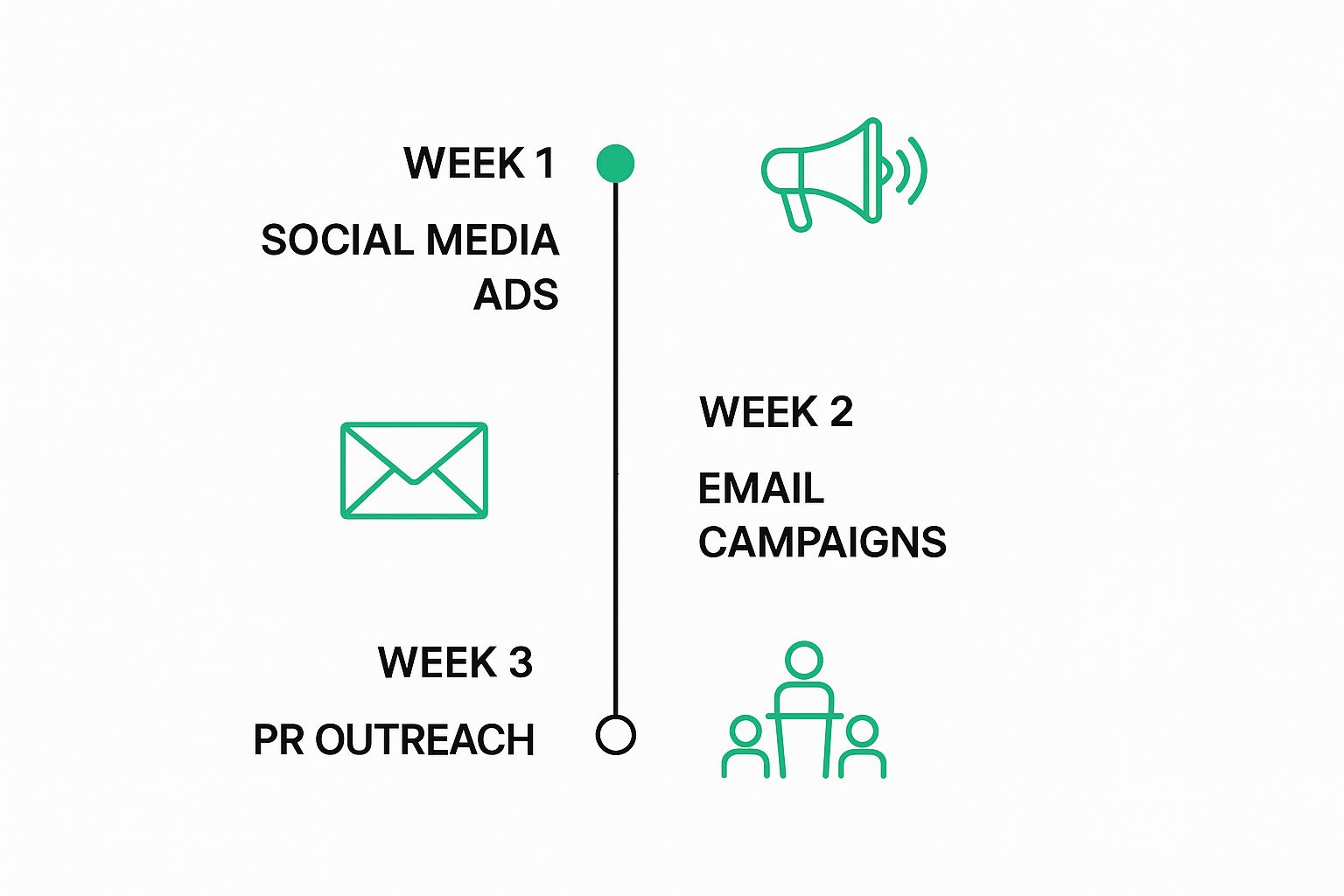Navigating the High-Stakes Launch Landscape

Product launches are exciting. They hold the promise of innovation and the potential for significant growth. But they're also inherently risky. The truth is, many product launches fall short of expectations. A solid product launch marketing plan is essential for navigating this tricky terrain. It's the roadmap that guides a product from its initial idea to its reception in the market.
Understanding the Odds
A crucial part of any successful product launch marketing plan is understanding the statistical realities. This means acknowledging the hard truth: many new products don't achieve their projected goals. In fact, roughly 95% of new products fail to meet anticipated market performance or customer adoption targets. Even more striking, only about 40% of developed products ever reach the market. This highlights the pre-launch challenges and the absolute need for a robust marketing plan. For more detailed statistics, you can learn more about product launch statistics. This high failure rate emphasizes the importance of thorough market research and a comprehensive strategy that truly connects with your target audience.
The Shifting Consumer Landscape
Consumers today face a constant barrage of choices, making it harder than ever to grab their attention. Traditional marketing often falls short in this fragmented marketplace. A successful product launch marketing plan needs to consider the evolving ways consumers discover and interact with products. This includes a deep understanding of social media, influencer marketing, and the increasing importance of authentic brand storytelling. Consider how a platform like IndieMerger, which connects solo founders, might leverage its community to boost its launch messages. This transforms the community into an active participant in the product’s journey, rather than just a passive audience.
The Psychology of Product Adoption
Reaching consumers is just the first step. A truly successful launch needs to resonate with them on a psychological level. What makes some products instant hits while others disappear? A critical factor is the perceived value. This goes beyond just features and dives into the emotional benefits the product offers. Does it solve a real problem? Does it create a sense of belonging or status? A winning product launch marketing plan taps into these desires, forging an emotional connection that drives adoption.
From Launch to Legacy
The ultimate goal of a product launch marketing plan isn't just a successful initial launch. It's about building a lasting legacy. This requires cultivating long-term customer relationships, continually gathering feedback, and adapting the product based on market response. This ongoing cycle of improvement is key to navigating the constantly shifting market and ensuring the product remains relevant and valuable to its target audience.
Market Intelligence That Actually Drives Decisions
Smart product launch marketing plans rely on more than just knowing your target audience's age or location. You need to understand their motivations and dig deeper than surface-level preferences. This requires gathering market intelligence that truly informs your launch strategy. For instance, uncovering unexpressed needs can reveal opportunities your competitors might be overlooking.
Uncovering Hidden Customer Motivations
Traditional market research often focuses on what customers say. Observing how they behave, however, offers richer insights. This could mean analyzing website traffic, social media engagement, or running A/B tests with different marketing messages. These behavioral clues can expose differences between what customers say and what they actually do.
Competitive Analysis and Positioning
A successful product launch also demands understanding your competitors. This involves more than just knowing who they are. It requires identifying positioning gaps and understanding how your product uniquely meets customer needs that other products don’t. This allows you to create a compelling value proposition that sets you apart.
Price Sensitivity and Perceived Value
Understanding price sensitivity is another critical element of market intelligence. This isn’t about finding the lowest price; it's about understanding how your target audience perceives value. What are they willing to pay for a product that solves their problem? Maximizing perceived value is often more effective than competing solely on price. Understanding the financial implications of misjudging the market, such as the true cost of abandoned carts, can be crucial for a strong product launch.
Transforming Insights into Actionable Strategies
Gathering market intelligence is only the first step. Next, you must transform those insights into actionable launch strategies. This means developing multi-dimensional buyer personas that go beyond basic demographics. These personas should represent your ideal customer’s needs, motivations, and pain points. For example, a persona might include preferred communication channels, their decision-making process, and their biggest objections.
Before the table below, we'll briefly discuss the importance of pre-launch research, and following the table, we'll summarize the key insights presented. Understanding these components will help you lay a solid foundation for your product launch.
To help illustrate this process, the following table outlines essential research components.
Essential Pre-Launch Research Components
| Research Component |
Why It Matters |
Data Collection Methods |
Implementation Tips |
| Target Audience Needs & Motivations |
Understanding what drives your customers allows for targeted messaging and product development. |
Surveys, interviews, focus groups, social media listening |
Focus on open-ended questions to uncover hidden needs. |
| Competitive Landscape Analysis |
Identifying your competitors' strengths and weaknesses reveals opportunities for differentiation. |
Competitor websites, market reports, customer reviews |
Analyze competitor pricing, features, and marketing strategies. |
| Price Sensitivity & Perceived Value |
Understanding customer willingness to pay helps determine optimal pricing strategies. |
Price testing, market research, competitor analysis |
Experiment with different price points to gauge customer reactions. |
This table summarizes the key areas of pre-launch research, outlining their importance and providing methods for gathering information effectively. Focusing on these components allows you to tailor your product and messaging to meet real market needs, maximizing your chances of success.
Testing and Refinement
Before investing heavily, test your value proposition. This could involve customer interviews, focus groups, or a beta program. This early feedback can help refine your messaging, product features, and overall launch strategy. This iterative process helps you identify potential problems and optimize your approach before launch, minimizing risk and maximizing your success.
Crafting Your Launch Strategy That Cuts Through the Noise

A well-defined product launch marketing plan is essential for success. It's the roadmap that guides your product from introduction to market acceptance. This section explores key strategies to create a launch that truly resonates with your audience and delivers tangible results.
Defining Measurable Objectives
Every successful product launch starts with clearly defined, measurable objectives. These objectives should be directly tied to your overall business goals, not just surface-level metrics. Think impact, not vanity. For example, instead of aiming for "10,000 followers" on social media, a more effective objective might be "generate 500 qualified leads within the first month." This focus on tangible results provides a clear benchmark for measuring success.
Crafting Compelling Messaging Hierarchies
Effective messaging is the foundation of any successful launch. This means developing a messaging hierarchy that delivers a compelling value proposition at every customer touchpoint. Consider how your message resonates with different segments of your audience. For example, IndieMerger could highlight the time-saving benefits of its AI matching algorithm to busy entrepreneurs, while emphasizing the community aspect for solo founders looking for collaboration.
Competitive Positioning Without Direct Attacks
Highlighting your product's unique strengths is crucial. However, directly attacking competitors can be less effective than focusing on your own unique advantages. This approach builds trust and credibility with potential customers. Showcase what sets your product apart without resorting to negative comparisons.
The Power of Product Narratives
Memorable product launches often weave a compelling narrative around the product. This story connects with your target audience on an emotional level, explaining not just what your product does but why it matters. For example, IndieMerger's narrative could focus on empowering solo founders to build their dream businesses together, facilitated by the platform.
Choosing the Right Marketing Channels
Selecting the right marketing channels is key for reaching your target audience. This means understanding not just where they spend their time, but also where they make purchasing decisions. Are they active on specific Reddit forums? Do they follow particular influencers on Twitter? Understanding these nuances allows for more targeted and effective campaigns.
Balancing Visibility and Resources
Ambitious goals are important, but they should be balanced with available resources. A successful product launch plan identifies the most impactful activities and allocates resources strategically. This ensures maximum impact for your efforts. For example, prioritize influencer collaborations or targeted advertising on platforms like Facebook over broader, less focused campaigns.
Building a Launch Timeline That Actually Works
Timing is everything when launching a new product. A well-structured timeline serves as the foundation of your product launch marketing plan, ensuring a smooth process and the ability to handle unexpected bumps in the road. This section explores building a timeline that generates momentum and keeps your launch on the right track.
Defining Your Critical Path
First, identify your critical path activities. These are the essential tasks that must happen for a successful launch. It's like constructing a building – you can’t install the roof before the foundation is set. Some marketing activities, like finalizing your messaging or securing partnerships, must be completed before others can begin. Prioritizing these tasks builds a solid base for your launch and helps you allocate resources efficiently.
Incorporating Buffer Zones
Even the best plans can encounter unexpected delays. Building buffer zones into your timeline protects against these roadblocks. This doesn't mean adding extra time to every single task. Instead, strategically add buffer time to critical path activities or phases where problems are more likely to occur. This flexibility lets you adapt to challenges without derailing the entire launch. For instance, if your product development team runs into a bug, a buffer zone in your pre-launch phase can absorb the delay without impacting your launch date.
Coordinating Teams
Product launches often involve many teams with varying priorities. Coordination is key. Think of it like an orchestra – each section plays a different part, but they must work together to create beautiful music. Your marketing, sales, product development, and customer support teams must be aligned and working towards the same goal. Regular communication and clearly defined roles are essential for a coordinated effort, minimizing conflicts and keeping everyone informed.
Pre-Launch Activities: Generating Excitement
Building pre-launch buzz is essential. But you need to be strategic, generating excitement without prematurely revealing competitive advantages. Think of a movie trailer: it builds excitement without revealing the entire plot. Your pre-launch activities, like teaser campaigns or working with influencers, should pique interest without giving away too much. This maintains a sense of mystery and builds anticipation for the launch.
Tailoring Your Timeline
Different products require unique timing considerations. A new software platform might need a longer pre-launch phase for beta testing and feedback. A physical product might prioritize retail partnerships and shelf space. A platform like IndieMerger, focused on connecting founders, might emphasize pre-launch community building. Understanding these nuances lets you tailor your timeline to your product and market.
The following timeline illustrates the key milestones and phases discussed above, visualizing the progression of a product launch from initial planning to post-launch analysis.

This timeline highlights the importance of distinct phases. The pre-launch phase emphasizes market research, product development, and preparing marketing materials. The launch phase marks the official release, including public announcements and initial sales. Post-launch involves performance analysis, customer feedback, and ongoing marketing adjustments. The built-in buffer zones within each phase provide flexibility and adaptability.
To further break down these phases, consider the following framework:
Product Launch Timeline Framework: A comprehensive timeline breaking down key activities and milestones across the pre-launch, launch, and post-launch phases
| Timeline Phase |
Key Activities |
Team Responsibilities |
Success Metrics |
| Pre-Launch |
Market research, product development, marketing material preparation |
Marketing, Product Development |
Brand awareness, lead generation |
| Launch |
Public announcements, initial sales efforts |
Sales, Marketing |
Sales figures, website traffic |
| Post-Launch |
Performance analysis, customer feedback, marketing adjustments |
Marketing, Customer Support |
Customer satisfaction, conversion rates |
This table summarizes the key activities, responsibilities, and metrics for each phase, providing a clear roadmap for a successful product launch. By focusing on these elements, you can ensure a well-structured and managed launch process.
Orchestrating Multi-Channel Launch Communications

A successful product launch involves more than just an announcement. It requires a coordinated communication strategy across various channels, amplifying your message and creating a unified launch narrative.
Adapting Messaging While Maintaining Consistency
Different platforms have different communication styles. Adapting your core message is crucial for resonating with each audience. For instance, the visual nature of Instagram demands a different approach than a detailed blog post. However, brand consistency is key across all channels, ensuring a recognizable and trustworthy brand experience.
It’s a balancing act: tailoring your content while ensuring a unified brand voice.
Leveraging Built-In Sharing Mechanics
Organic reach can significantly boost your message. Design launch content with built-in sharing features, including social media buttons, embedded links, and clear calls to action. This is like word-of-mouth marketing amplified by technology. Each share expands your reach, leveraging audience networks. Platforms like IndieMerger can encourage founders to share their successful co-founder matches, generating organic promotion.
Platform-Specific Strategies: Playing to Strengths
Generic cross-posting weakens your message. Tailor your strategy to each platform's strengths. Video excels on YouTube, while discussions thrive on Twitter. IndieMerger could use LinkedIn to target professionals, highlighting its AI-powered matching for co-founder searches. This approach prioritizes quality engagement over quantity of posts.
Generating Media Coverage Through Newsworthy Angles
Media coverage adds credibility. Craft newsworthy angles that attract journalists. This could be a unique product feature, a compelling founder story, or a notable partnership. IndieMerger might showcase its success rate in connecting founders, addressing the challenges faced by solo entrepreneurs. This targeted approach can garner media attention, building authority.
Visual Assets: Cutting Through the Clutter
Compelling visuals are essential. Invest in high-quality images and videos that communicate your product's value and brand. These are your product's first impression. Visually appealing content on platforms like Instagram and Facebook can capture attention and draw users into your narrative.
Leveraging Existing Relationships
Your existing customers and partners are valuable. They can amplify your launch by sharing their positive experiences within their networks. This organic amplification builds authenticity and reinforces your brand message. IndieMerger can leverage its existing founder community for promotion, creating a ripple effect of organic growth.
By strategically orchestrating your launch communications, you create a resonant narrative that maximizes your launch impact and converts potential customers into enthusiastic adopters.
Measuring What Matters and Optimizing Post-Launch
The product launch marketing plan journey doesn't end with the initial announcement. The real work starts after launch, focusing on continuous monitoring, analysis, and optimization. This post-launch phase is where you transform initial excitement into lasting, sustainable growth.
Establishing Key Performance Indicators (KPIs)
Before launch day, establish a clear set of Key Performance Indicators (KPIs). These metrics should move beyond superficial metrics like social media followers and concentrate on measurable results.
For instance, track conversion rates, customer acquisition cost, and customer lifetime value. These KPIs offer a data-driven perspective of your launch's effectiveness and inform future improvements.
Leading vs. Lagging Indicators: A Balanced Approach
A strong product launch marketing plan uses both leading and lagging indicators. Leading indicators, like website traffic and demo requests, offer a glimpse into future performance. Lagging indicators, such as sales revenue and customer churn rate, reflect past performance.
Using both types of indicators provides a comprehensive understanding of your launch's impact and enables timely adjustments.
Rapid Response and Real-Time Adjustments
The post-launch environment is constantly changing. Be ready to adapt to shifting market conditions and customer feedback. This rapid-response approach requires continuous monitoring of your KPIs and identifying underperforming aspects of your marketing mix.
When preparing your multi-channel launch communications, explore different approaches like those found in Ecommerce Subscription Models. Implement real-time adjustments to maximize launch impact and capitalize on new opportunities.
Capturing and Utilizing Customer Feedback
Customer feedback is essential for refining your product and marketing strategies. Use feedback capture mechanisms like surveys, social media listening, and customer support interactions.
Turn these insights into product improvements and targeted marketing campaigns. This customer-centric approach cultivates loyalty and promotes long-term growth.
Extending Launch Energy: From Event to Engine
A successful product launch isn't a one-time event; it fuels sustained growth. Maintain the initial buzz through targeted follow-up campaigns, showcasing customer success stories, and celebrating important milestones.
This ongoing engagement transforms the launch from a single event into a sustainable growth engine, driving continuous customer acquisition and product adoption. As an example, IndieMerger could highlight successful founder pairings, demonstrating the platform's value and attracting new users.
Are you a solo founder looking for the ideal partner to realize your startup vision? IndieMerger connects entrepreneurs with complementary skills, empowering you to build a thriving business. Visit IndieMerger today and discover the potential of partnership.